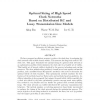Free Online Productivity Tools
i2Speak
i2Symbol
i2OCR
iTex2Img
iWeb2Print
iWeb2Shot
i2Type
iPdf2Split
iPdf2Merge
i2Bopomofo
i2Arabic
i2Style
i2Image
i2PDF
iLatex2Rtf
Sci2ools
ICCAD
1993
IEEE
1993
IEEE
Optimal sizing of high-speed clock networks based on distributed RC and lossy transmission line models
We have proposed an e cient measure to reduce the clock skew by assigning the clock network with variable branch widths. This measure has long been used for \H" clock tree. This paper formulates the optimal sizing of a general clock network as an optimization problem which minimizes the clock skew in a feasible set of widths. This feasible set of branch widths is decided by the process technology and routing resources. The skew minimization problem is turned into a least-squares estimation problem, and a modi ed Gauss-Marquardt's method is then used to determine the optimal widths of clock branches. This optimization method combines the best features of the methods based on Taylor series and methods based on gradients. An e cient algorithm is also proposed that assigns the good initial widths especially for a clock tree which let the later optimization process converge much more quickly. Our method is very exible and can handle the general clock network including loops. The ...
Clock | Clock Network | Clock Skew | Hardware | ICCAD 1993 |
| Added | 08 Aug 2010 |
| Updated | 08 Aug 2010 |
| Type | Conference |
| Year | 1993 |
| Where | ICCAD |
| Authors | Qing Zhu, Wayne Wei-Ming Dai, Joe G. Xi |
Comments (0)

